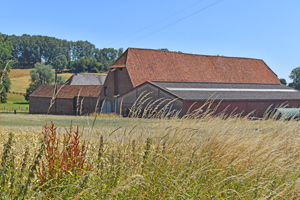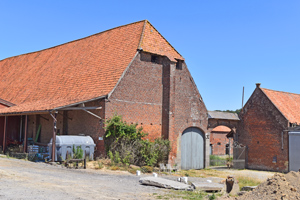
On 10th November 1918, 11th East Yorkshire Regt., in the vanguard of 92nd Infantry Brigade, advanced 12,000 yards (11km) before taking up positions for the night on the high ground north of Flobecq.1 11th East Lancashire Regt. (Accrington Pals) were billeted for the night in the village of Quesnau [Queneau] 3,000 yards (2.9km) behind the forward positions.2 The march eastwards seems to have been made amidst an atmosphere of celebration: " The same scenes of enthusiasm occurred as at our entry into Tourcoing last month and the civilian population did everything possible to show their joy at the departure of the enemy. Wine was dug up from back gardens in which it had been secreted for four years and given liberally to everyone as were the other refreshments."3 Brigade orders for the following day were to continue the advance with an Advance Guard under the command of Major Lewis Hewitt Lewis, composing 11th East Lancashire, 'A' Battery of 170th Brigade, Royal Field Artillery, 'B' Company of 31st Battalion, Machine Gun Corps, two platoons of XIX Corps cyclists and No.7 Motor Machine Gun Company.4 The battery of field artillery had been attached to the leading infantry battalion since the crossing of the Escaut [Schelde] river, chiefly in order to silence any active hostile machine guns. 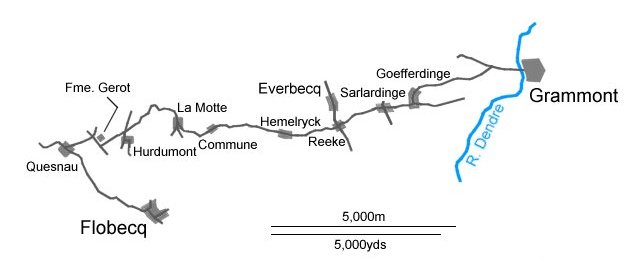 Above: Likely route followed by 11th Bn., East Lancashire Regt. on 11th November 1918. In the early hours of 11th November, news was received that the enemy had accepted the terms on which the Allied governments were prepared to grant an armistice, and that hostilities would cease at 11am. Thirteen years later, Accrington Pal Russell Bradshaw would recall that he had been on duty at battalion headquarters when the message came in at 2am, and that at first the news seemed to be given little significance.
Above: Ferme Gerot, Advanced Guard Headquarters of 92nd Infantry Brigade on the morning of 11th November 1918. Photographs taken by the author in July 2018. Advance Guard Headquarters opened at Ferme Gerot at 7am on 11th November. Bradshaw’s memory of the announcement of the Armistice being given to the battalion at 9am is that it was received in silence. As the men stood in the road, waiting for the advance to continue, some entered a nearby house: "Soon they were drinking coffee and chatting with the good housewife. Then entered another fellow who immediately asked the woman if she had anything to eat in the house. Fifteen minutes later she appeared with a big plate of chips...the good lady was asked to produce more ‘toute suite’, which she did. The fellow who had ordered food offered the usual two franc piece for his meal but the woman refused it, saying ‘I would very much like a button off your tunic’. Promptly a button bearing the Sphinx was cut off, and she took this with many thanks saying she would have it made into a brooch. Then came orders to advance, and men rushed outside, gathered up their goods and chattels and marched away to the east."5 The battalion passed through the lines of the 11th East Yorkshires and pressed on through "soaking wet Scotch mist and fog"6 with orders to establish a line of picquets as close as possible to the Dendre river before hostilities ceased. Surprisingly, there is some doubt as to how far the battalion had marched by 11am; the war diary of 11th East Lancashire is unhelpful, as it records only that the battalion established posts east of Goeferdinge before midnight. According to Crabtree and Sayer, writing some twenty years later, the battalion was still three miles west of Everbecq [Everbeek].7 The best contemporary source is the war diary of 170th Brigade, R.F.A. which states that the infantry had established a line of picquets on the high ground overlooking Grammont [Geraarsbergen] and the line of the Dendre before the cessation of hostilities. Given that all Armies had been ordered not to advance east of the line gained by them at 11am8, and knowing the location of 11th East Lancashire at the end of the day, it seems likely that the battalion had reached Goeferdinge by 11am. There is also the evidence of the photograph, taken in daylight (i.e. before 5pm) in front of the Château de Goeferdinge [Goeferdinge Kasteel]. 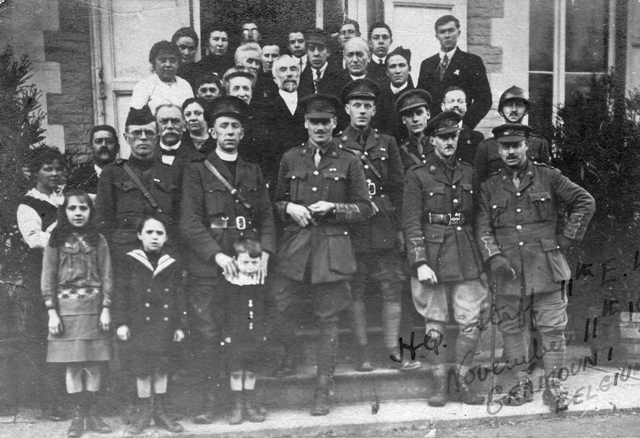 Above: Officers of the 11th Bn., East Lancashire Regt. outside of Château de Goeferdinge [Goeferdinge Kasteel] on 11th November 1918. Capt. John Shire Duff M.C. and Bar is standing in the centre at the front (on the Padre's left); Capt. Spencer Richard Fleischer D.S.O., M.C. is standing second from the right at the front; the owner of the château, Arthur van der Linden, is standing behind Capt. Duff. Photograph by kind courtesy of Jane Maclean. It does, however, appear that 11th East Lancashire overstepped orders by continuing to advance beyond 11am, before returning to Goeferdinge. Accrington Pal Jack Smallshaw wrote in his diary: "At 12 noon [on 11th November] we got orders to again pursue the Germans so we were on the advance all day again. 7 p.m. this evening found us at Goefferdinge [sic] where we received a hearty welcome once more. The Nuns at the Convent here made scores of us soup and etc also providing sleeping rooms for the lads."9 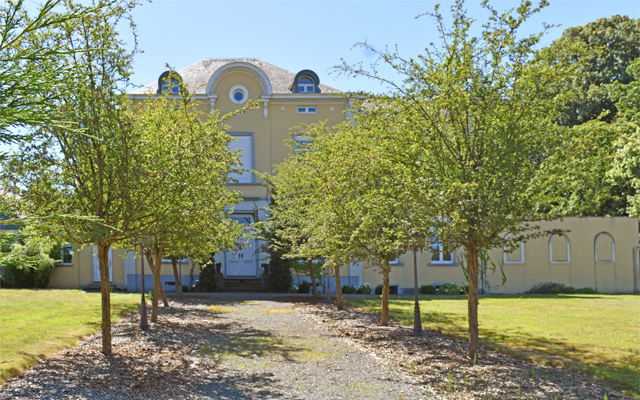 Above: Château de Goeferdinge [Goeferdinge Kasteel]. Photograph taken by the author in July 2018. 217 weeks after the first recruits to the Accrington Pals battalion joined up on 14th September 1914, the war was over. In its time on the Western Front, the battalion had suffered an estimated 2,920 casualties.
© Andrew C Jackson 2018
|
